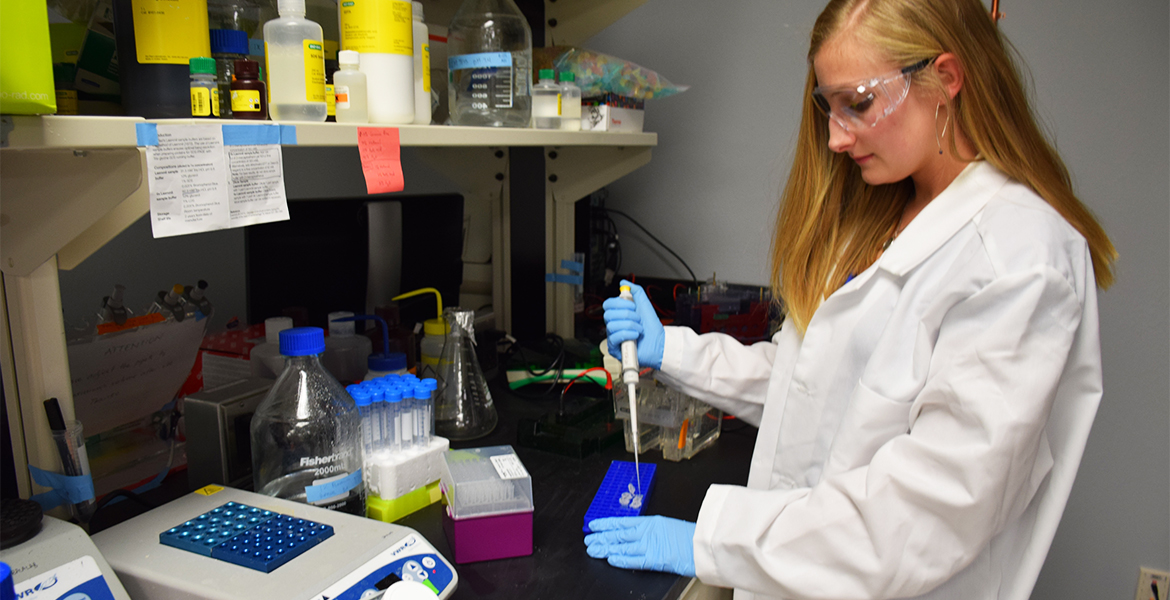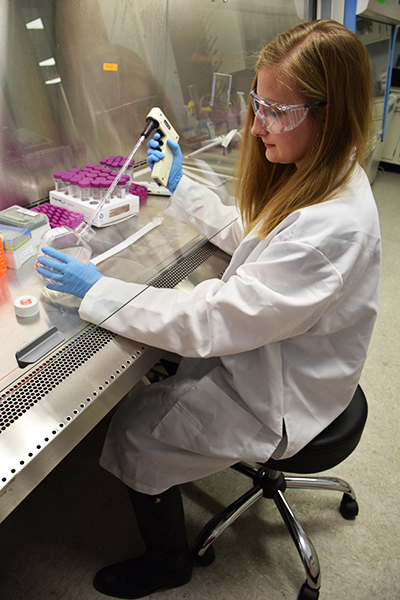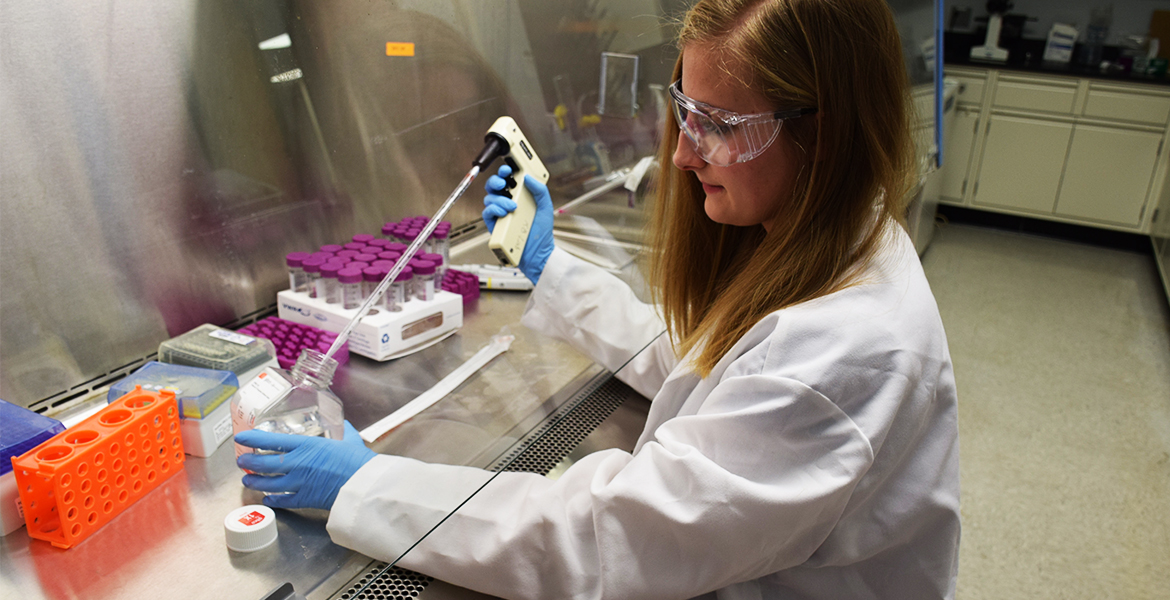Amanda Ederle is a student in the Biomedical Engineering Department at the University of Arkansas. She works under Dr. Kartik Balachandran in the Mechanobiology & Soft Materials Laboratory, and was recently awarded a SURF grant to continue her research work.
UArk BME: When you first arrived at the U. of A. as an Honors College Fellow, did you know what you wanted to study?
Ederle: I am actually a Public Health major, but I am doing biomedical engineering research for my Honors Thesis. I think my situation exhibits one of the great aspects of the Honors College. I can explore my diverse interests and incorporate all of them into my undergraduate education. I was originally drawn to public health because I was interested in exploring the broad perspective of medicine and health. I think that it is important for me to study public health because of the new focus on prevention techniques in the clinical medicine world; as a future physician, my public health background will provide me with the tools to examine health from a holistic perspective, originating as much from social aspects as genetic ones. However, though I love my public health courses, I found that I missed certain aspects of the sciences. I began to look at the research in the hard sciences on the U. of A.’s website, and Dr. Balachandran’s research really stood out to me. I reached out to Dr. B to express my interest, and the rest is history!
UArk BME: You spent last fall studying abroad as part of the School for International Training’s (SIT) International Honors Program/Comparative: Health and Community Program. How did that experience expand and build upon the education you’ve received to date?
Ederle: The International Honors Program was absolutely one of the most formative experiences that I have had in my undergraduate education. During this program, I studied comparative global health in four distinct locations: San Francisco, USA; Hanoi, Vietnam; Islington, South Africa; and Buenos Aires, Argentina. In addition to examining the individual public health barriers that each location faced, I also studied the biological, socio-cultural, economic, political, and environmental factors that affect the overall health of a nation. Each country had a rural stay and an urban stay, which allowed us to see the distinct differences in not only lifestyle but also health within each nation itself. For sixteen weeks, I traveled with twenty-one other college students to four continents, three of which I had never set foot upon before. Not only was the program academically intense, but it was also emotionally, socially, and physically demanding.
Though this program had its challenges, I learned to listen to the voices of the people around me. From Global North to Global South, from urban to rural, and across the political spectrum, I learned to engage with people in ways that I could have never imagined. I grew from a nervous traveler to a student who now feels comfortable traveling to foreign countries. I was honestly amazed by the kindness of people around the world, from those who welcomed us into their homes, to those who we interviewed for projects, to those who drove our buses. Most of all, I learned how truly interconnected each and every one of us is with our neighbors, whether they are down the street or on the opposite side of the world.
With regards to academics, IHP allowed me to see the impact of worldwide public health concerns: HIV/AIDS, environmental pollution, non-potable water, and malaria. My U. of A. public health courses, such as Environmental Health and Foundations of Public Health, provided me with a great knowledge base for this program. I was familiar with health theories, program planning and implementation, and general public health terminology; this knowledge allowed me to engage more readily and confidently with the concepts that we learned about during our IHP academics.
Another interesting aspect of IHP was my independent research project examining alternative and traditional healing methods in all four countries as part of my coursework. My research consisted of in-depth interviews, surveys, and participant observation; at the conclusion of the semester, I presented my findings to my fellow classmates and examined methodology, research challenges, and cross-cultural comparisons. This ethnographic research was unlike any of my previous research experiences as it was anthropological in nature and stemmed from qualitative methods.
Looking back on this program, I am honestly amazed at the knowledge that I gained and the places that I visited. From rural Vietnam to Table Mountain in South Africa to La Pampa in Argentina, the world is full of people who each have a story to tell; I am glad to have added this adventure in a chapter of mine. It was truly a once-in-a-lifetime experience.
UArk BME: With regard to work you’ve done at the U. of A, what’s it been like working in the lab under Dr. Balachandran?
Ederle: Dr. Balachandran is great! He and his graduate student, Nasya Sturdivant, have always been incredibly patient with me since I am not as familiar with the techniques utilized in a biomedical engineering lab. Dr. B has allowed me to learn from my mistakes in the laboratory, and made himself available for me (and all of his laboratory students) to ask questions, learn new techniques, and take on new projects. I am very grateful to Dr. B for giving me the opportunity to work in his laboratory. His research is so engaging and applicable, which is what really sparked my interest. Plus, we get pizza at the bi-monthly laboratory meetings!
UArk BME: What was the application process for a SURF Award like? What was the most challenging part of the process for you?
Ederle: The application for the SURF Award was fairly extensive. I started mine in late May because I knew that I would have to submit my completed application to the Office of Nationally Competitive Awards before I left for my study abroad program. In addition to two recommendation letters and an official transcript, my part of the application consisted of a resume, a one-page abstract, a budget justification sheet, and a five-page research proposal. Dr. Balachandran also had to submit his CV and a letter of support. I had a lot of support from Dr. B, Nasya Sturdivant (Dr. B’s graduate student), and the other students in my lab, though. Two students had been awarded the SURF the year before, and they were more than willing to share tips with me. It was great to have that support—I could not have done it without them! It’s truly a team effort.
The most challenging part of the application for me was writing the five-page proposal. I had to do extensive outside research in order to find journal articles to provide background information and justify why I was using certain techniques. This was my first research proposal, so there was quite a learning curve for me. As I mentioned above, Dr. Balachandran, Nasya, and Dr. Jeremy Burns in the Office of Nationally Competitive Awards all edited my application and helped me along the path to writing a good proposal.
UArk BME: How did you react when you found out you’d won the award?
Ederle: I was actually sitting in a coffee shop in Buenos Aires when I found out that I had been awarded the SURF. I was working on a group project really early in the morning, and my mom texted me a picture of the letter. I was honestly more surprised than anything else! I did not expect to hear back until the spring. I had submitted the application in October, and I heard back in late November. I was so thrilled and honored—the first time I had heard about this award was during my freshman year, and I had been waiting until my junior year to apply. But it was definitely worth the wait.
UArk BME: Can you describe the research you’ll be doing with the SURF Award?
Ederle: I will be examining the effect of AQP4 (a water channel in the blood-brain barrier) inhibition on astrocyte swelling, viability, and injury following a simulated traumatic brain injury (TBI); I am also interested in examining the most effective time at which the AQP4 inhibitor can be added relative to the TBI in order to prevent edema (swelling). One of the main concerns associated with traumatic brain injury is the part that happens after the initial impact: the brain begins to swell as the blood-brain barrier becomes more permeable, which leads to a multitude of other problems such as seizures and loss of consciousness. The AQP4 channel is a water channel, so it is easy to imagine the importance it has in brain swelling and long-term damage following a traumatic brain injury.
UArk BME: Any advice for other U. Ark. students looking to apply for awards?
Ederle: I would highly encourage U of A students to apply for any award in which they might be interested (study abroad, research, etc). Apply for as many as possible and do not get down when you get rejected from a few. Also, make sure you keep your GPA high—this always helps when applying for awards. Dr. Suzanne McCray and Dr. Jeremy Burns in the Office of Nationally Competitive Awards are both amazing to work with. They will not only give you options for awards based on your academic and career interests, but they will also edit your applications countless times. There is a lot of funding out there, but you just have to seek it out and then use your resources at the U. of A. as support in the application process.
UArk BME: Outside of class, you’re extremely busy [you discuss volunteering, acting as a research assistant, and being a founding member of the Foundation for International Medical Relief of Children (FIMRC)…!!]. How do you balance everything, and what keeps you motivated?
Ederle: This is a really good question. Sometimes it is really hard to stay balanced and motivated through everything! One of the best things that I do for myself is keep in contact with my family. Rarely does a day goes by without me speaking with my sister and parents. This constant communication keeps me grounded and allows me to keep a healthy perspective on most situations. It is easy to get caught up in a bad grade or a rejection from a scholarship, but having my family around always makes me feel accepted, supported, and loved.
Another one of my tactics is to set goals that are not school or extracurricular related. This helps to keep my passions alive because life is not all about class and college. For example, one semester, I took an American Sign Language course at Northwest Arkansas Community College. This semester, my goal is to get my dog (Chip) registered as an official Pet Partners Therapy dog. This certification will allow me to bring Chip into hospitals and nursing homes to socialize with patients and families. Pet therapy has been proven to have positive effects on physiological factors (such as blood pressure) and mental health (such as stress level). This is the first time I have ever trained a dog as strictly as Chip, so we are learning together. I think this is a great way to bring meaning to Chip’s life and share a bit of the love that I have for him with the rest of the world. Our evaluation is in March, so wish us luck!
Furthermore, I keep a calendar with everything I have to do—from errands to homework—written on it. I do not know what I would do without it. Seeing my to-do lists allows me to practice my time management skills and get started on assignments in advance. This helps me to keep my stress levels down, so I have more personal time for friends and relaxation.
Lastly, I think it is always important to remind myself to enjoy my time in college. Rarely does a single event such as an exam or paper determine the course of my life. I truly believe that when a situation is supposed to work out, it will. Perspective is perhaps the most important aspect of maintaining a balanced life, and I try to take a step back from a situation when needed.
UArk BME: In past articles, you’ve mentioned an interest in attending medical school after graduation. Are there specific aspects or branches of medicine you’re interested in?
Ederle: Wow, this is a big question! I do enjoy certain specialities more than others. From my shadowing experiences, I think that I have learned some specific values and characteristics that I would like to carry out into my future specialty. I definitely enjoy hospital specialities more than clinic-based specialties. I also thrive off of patient contact, so I want to incorporate this into my future profession. In addition, I want to maintain a balance between my professional and personal life, which will require a specialty with more flexible hours and less on-call. So far, I have found that I love cardiothoracic surgery (general surgery not as much). I am hoping to get some more shadowing experiences in this summer, which will hopefully help me decide on my path in medicine.
Additionally, I am committed to incorporating my public health background into my future career as a physician. From my time at U. of A. and my IHP study abroad program, I learned that the successful trajectory of clinical medicine often depends on clinical research and public health policy. Though the two may seem to fall in separate realms, the goals of public health align with those of clinical medicine as they both seek to improve patient health and outcomes. I believe that a physician who is also knowledgeable about public health is able to cater more towards preventative measures (which is something that I strongly believe in) and examine a patient with a wide-angle lens of the population’s overall health.
UArk BME: A Biomedical Engineer learns she is going to be stranded on a deserted island, and will be allowed to bring only three items with her. What does she bring?
Ederle: According to Mythbusters, I should be able to survive with just duct tape, so I would definitely bring a large roll of that. I would also bring a hammock with a mosquito net (because I would get eaten alive without the mosquito net) to sleep in during the nights (and possibly during the day because, hey, if I’m stranded on a desert island, who’s going to judge me?). The last item I would bring is a boat with a full tank of gas and GPS to leave the island when I’m ready to reemerge in society!





